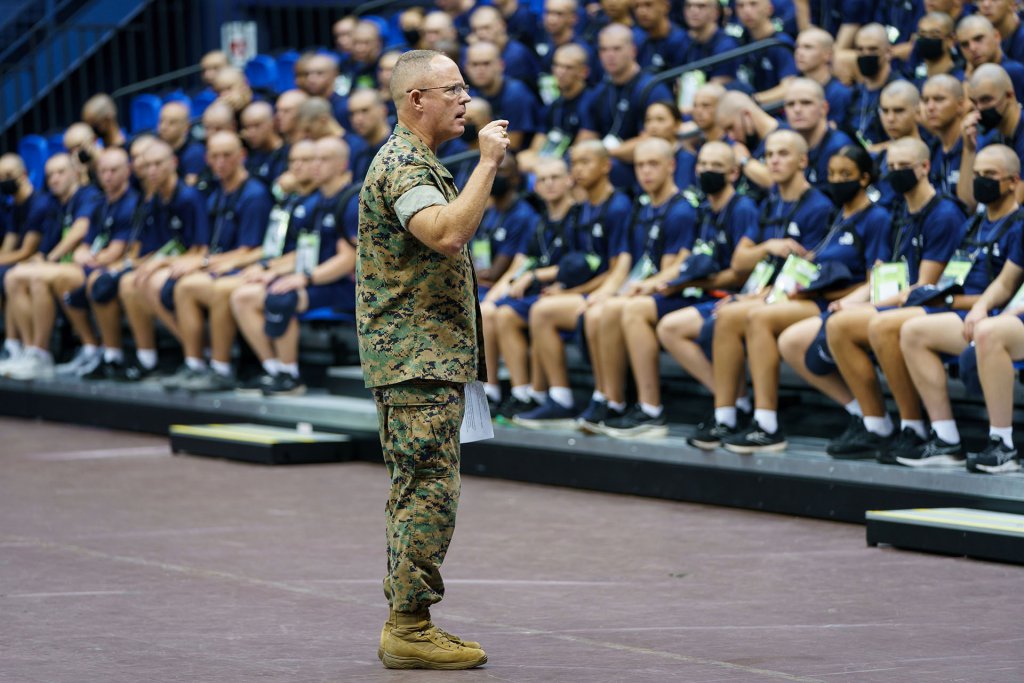In some ways, he is like any other cadet—he has an Instagram account and a One Card. He likes to eat and sleep and hang out with his friends. He’s been known to fall asleep in organic chemistry, and Col. Suzanne Mabrouk even jokingly threatened him with cons because it’s hard to lecture above the din of his snores. Cadet Gen. Mike D. Groshon, or G3 as he’s known, matriculated with the Class of 2023 and is the highest-ranking cadet. G3 also hails from an impressive line of English bulldogs and arrived on campus in the fall of 2020 woefully out of shape.
Fitness is one of the Four Pillars of a Citadel education. Mandatory physical training ensures good health, mental alertness and emotional well-being, and G3 is a willing participant and an inspiration to the Corps.
“When we first got him, he was really out of shape, and he didn’t like to do much more than get out of bed and play a little fetch with us,” said junior Cadet Sienna Gonzalez, one of six cadet dog handlers who live in the Mike Groshon House on the corner of Richardson and Mims Avenues.
G3 and the doghouse are both named for Mike Groshon, who passed away in 2016. Groshon was a member of the Class of 1976 and a long-time employee who cared for several generations of bulldog mascots.
After working out with cadets, enduring salutes by knobs, sprinting across the parade field, trotting to class, greeting his adoring public and playing Ultimate Frisbee, G3 is in the best shape of his life.
“He still hates the heat. When I take him for walks when it’s hot, he pants and runs for shade,” said Gonzalez, who took care of him at her home in San Antonio, Texas, over the summer. “He loves my family and my dogs. He’s like a little polar bear.”
All members of the Corps of Cadets are required to participate in physical training, or PT as they call it. This includes G3. While he cannot do pushups, he is good for morale.
The Bulldog Handling Program is in its second year of operation. Six carefully vetted cadets—two seniors, two juniors and two sophomores—are chosen to live with G3 in the Groshon House as part of the rank board process. The seniors are captains responsible for planning. The juniors serve as master sergeants responsible for administration and logistical support. And the sophomores are corporals responsible for his daily care and handling. They are a self-sustaining unit, and in addition to having their own housing, they have a jeep, and they ensure that G3 gets to class and to the many guest appearances he must make as a campus celebrity.
“We wanted to get the bulldog more involved with the Corps,” said Sgt. 1st Class Arthur Rich, who heads up the Department of Cadet Activities. “Before, it was just alumni who had access to him. You didn’t see him around campus that much, you didn’t see him at PT, you didn’t see him at Recognition Day, so when we placed the bulldog with the cadets, the idea was that he would go everywhere cadets go. It has worked, and the response has been good. Last year at matriculation, freshmen at their first PT session saw G3 out there, and it gave them a boost.”
After returning from Texas this summer, G3 found himself once again in organic chemistry, this time with sophomore Cadet Kimberly Winkler, a biology major. Despite G3’s snores, Mabrouk is delighted to have him in her class. And for his part, G3 is thrilled to be back. Mabrouk is actually fond of him, and she keeps a stash of Milkbone treats just for him.
Being top dog has its perks.

What is The Citadel Mascot?
I come from a long line of Generals and Boos
I eat knobs and Paladins and kangaroos
If you’re scared of my bark, don’t mess with my bite
For The Citadel blue I’ll do what is right
Peace and honor, God and country, I will fight for thee
I’m The Citadel bulldog. It’s a great day to be me!
Knob Knowledge poem



